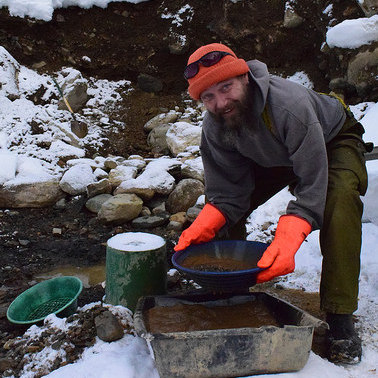Gold panning is still alive and well on the Wild Horse River near Fort Steele, B.C.

Lathem whirls the pan in water to remove the larger stones, leaving only a sandy sludge. — Nowell Berg photo Twenty years ago Stephen Lathem had a va
Lathem whirls the pan in water to remove the larger stones, leaving only a sandy sludge. — Nowell Berg photo
Twenty years ago Stephen Lathem had a vague dream about being a gold miner. He first ventured into the Wild Horse River area in 1999. The Wild Horse River is a tributary of the Kootenay River, joining near Fort Steele, B.C.
It wasn't until 2002 that he staked a claim nearby on Boulder Creek. In 2004, Lathem obtained a claim on the Wild Horse after it expired from the previous owner.
It would take several more years and a tour through Alaska, Dawson City, Spain and Italy before he got a mine up and running. Lathem went to Europe to participate in the 2008 World Goldpanning Championship in Spain and then 2009 in Italy, where he was the 12th fastest panner in the world.
In the fall of 2008, Lathem started Nip & Tuck Gold Mine. He found the name referenced on an old map at Fort Steele Historic Park. The name referred to an old water ditch that was dug in the mid- to late 1800s.
“They dug a lot of ditches in this valley to get water higher on the banks and benches," said Lathem. "On that map there was a Nip & Tuck water ditch that comes off the creek in this area. I thought this was a catchy name.”
Not only is Nip & Tuck an operating gold mine, but in the summer months Lathem invites tourists to travel the 12 kilometres from the Fort Steele/Wardner Road high into the mountains and experience what it's like to pan for gold. For a small entrance fee, you get a whole day panning and you keep what you find, small or big. It's worth the trip up the side of a mountain, but it won't be what you expect. As Lathem puts it, “by the time [tourists] leave, it's an education, it's something they had no idea existed or that there were still people out here digging for gold.”
Lathem's real passion is working the claim and pulling out gold nuggets. In the fall of 2015, a two-ounce nugget came out of the Nip & Tuck. “It's the biggest that's come out of the Wild Horse in the 20 years I've been digging here.” In the 1860s during the first gold rush on the Wild Horse, Mike Reynolds pulled out a 36-ounce nugget.
According to Lathem, a nugget that large would be about the size of a man's fist.
He has heard it all from many people about the futility of gold mining on the Wild Horse or Boulder. “People told me the old timers got it all—you're wasting your time," Lathem said. "I've since proven that not be the case. There's tons of gold up here,” he said.
The Wild Horse River is a vast area that was barely touched in the two gold rushes (1865 and 1888). Back in the day, miners would pan a creek and if they didn't find gold, they'd move on to the next creek, and if it didn't pan out, they'd move on again.
With pride, Lathem states, “I'm not weighing my gold in grams or ounces anymore, I'm weighing it in pounds.”
“Twenty years ago I had a little bit of a dream, but never imagined that it would actually happen, now I'm doing pretty much what I had envisioned,” said Lathem.
With a twinkle in his eye and itching for spring, Lathem is prepared for the long haul. As he said, “The land is large, gold is small and life is short.”




